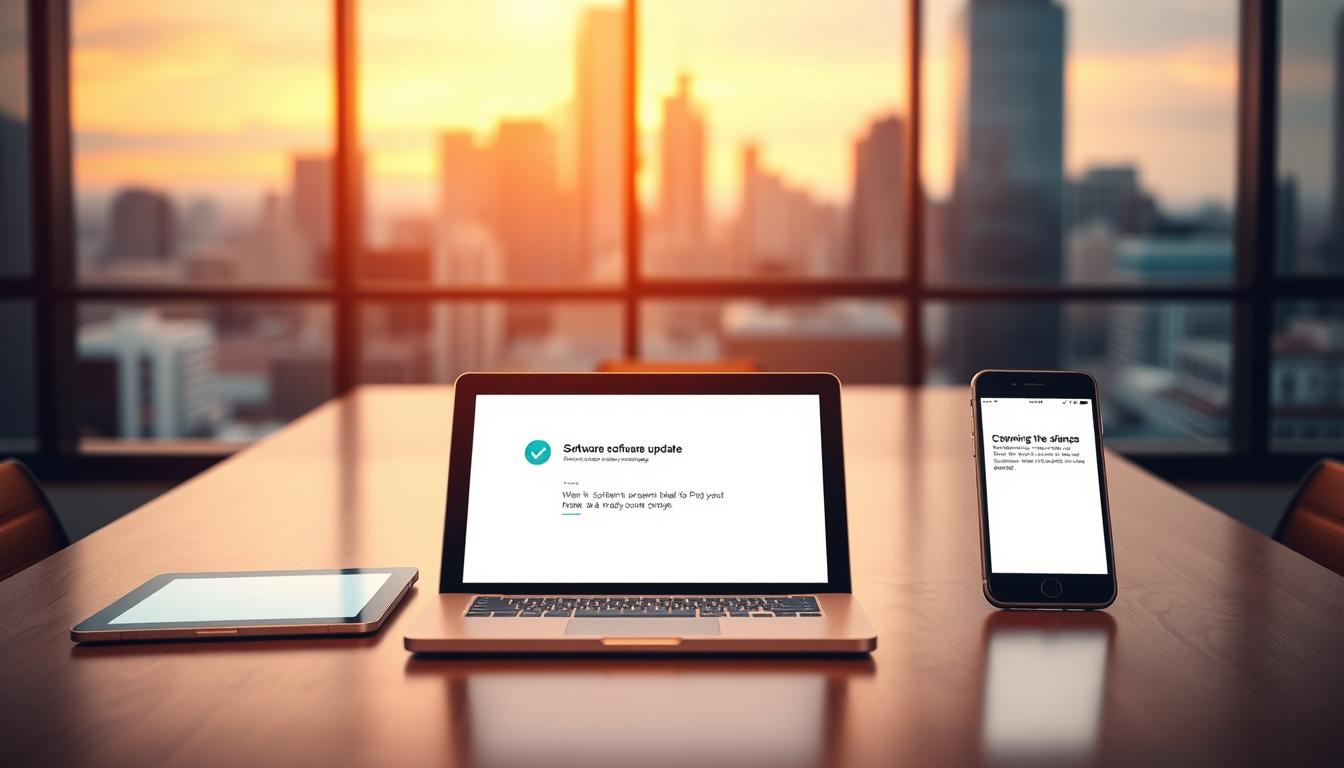Ever wondered why some companies handle software updates smoothly while others struggle? The key is in how well they communicate. In the Philippines, small and medium businesses are growing fast. They face big challenges when moving to new systems.
It’s not just about the tech. It’s also about making sure employees are ready and know what’s happening. When staff is prepared, updates go smoothly. This keeps work flowing and makes everyone happier.
Key Takeaways
- Effective communication is crucial for successful ERP updates.
- Preparing employees minimizes disruptions during software transitions.
- Clear communication fosters a supportive environment for staff.
- Proactive strategies can maintain productivity and morale.
- Understanding employee concerns is essential for seamless transitions.
Understanding the Importance of Software Communication
Clear software communication is key for smooth employee transitions during updates. Employees often worry about new software. They need open talks to feel secure and ready for change.
Why Employees Need Clear Communication
Employees do best when they get all the info they need. Uncertainty can make them anxious, which is common with software changes. Clear talks help explain the reasons and benefits of updates.
This makes employees more confident and open to change. It also builds trust in the workplace.
Benefits of a Smooth Software Transition
A smooth transition brings many benefits, like better productivity and happier employees. When employees know what’s happening, they adapt faster. This leads to teams working better together.
Everyone feels more confident in using new technology. This creates a positive work environment. Clear communication makes the transition a chance for growth, not just a task.
Assessing Your Organization’s Needs
Organizations should focus on what their employees think when looking at software updates. Getting feedback from employees helps make better decisions. It ensures new systems meet the real needs of the organization.
By involving employees, you build a team that works together well. This encourages everyone to be part of the change.
Gathering Employee Feedback on Current Software
To really understand how current software works, organizations need to ask their employees. Surveys, focus groups, and casual chats are great ways to get feedback. This feedback shows what’s not working and what could be better.
It helps choose the right updates for the future.
Identifying Areas for Improvement with Software Updates
Every company should check its software regularly. Looking at what employees say helps find what needs to get better. This way, updates can make work easier and more efficient for everyone.
Planning Ahead for Software Updates
Getting ready for software updates needs a good plan and clear talks. A detailed transition timeline helps all staff know what’s coming. This makes the change easier for everyone. It’s important to get input from key people who will help with the update.
Detailed Transition Timeline
A good transition timeline shows every step of the update. It lists tasks, deadlines, and who’s responsible. This keeps everyone in the loop about what’s next.
Clear goals help track progress and keep the team on track. When everyone can see the timeline, it boosts teamwork and gets everyone involved.
Involvement of Key Stakeholders in the Planning Process
Getting stakeholders on board is key to a successful update plan. These are team leaders, department heads, and IT experts. They know their areas well.
Inviting them early helps plan better and brings different views together. Talking openly helps everyone work together. This leads to better results for the company.
Training Employees on New Software Features
Getting employees ready for new software features is key. Making detailed educational materials helps everyone know how to use the updates well. Using different training methods can really help staff get on board.
Creating Inclusive Training Materials
Creating materials that fit different learning styles is a great way to reach more people. Here are some training resources to consider:
- Visual aids like infographics and videos to show complex steps.
- Written guides that employees can look at later.
- Hands-on workshops for practicing new software skills.
Offering these different formats makes training more accessible. It lets everyone learn in a way that feels right for them.
Ensuring Various Learning Styles are Catered For
It’s important to remember that people learn in different ways. Using many teaching methods can make training better. For instance:
- Group discussions and Q&A sessions create a team atmosphere.
- Learning from each other helps team members share knowledge.
- Follow-up sessions help with any questions or problems after training.
By catering to different learning styles and encouraging interactive training, companies can make the transition smoother. This leads to better productivity for everyone.
Communicating Software Updates Clearly and Effectively
It’s key to tell employees about software updates clearly. Using many ways to share news makes sure everyone gets it. This way, everyone knows what’s happening, when, and how it will change their work.
Utilizing Multiple Channels for Communication
Employers should use different ways to share updates. Emails, team meetings, and internal chats help keep everyone in the loop. Telling staff about updates often helps reduce confusion and boosts trust.
Setting Expectations and Addressing Concerns
Being clear about what updates mean is important. Employees like to know what to expect and how it will affect their work. This helps them feel more at ease and builds a strong team.
By listening to feedback, companies can really understand what their staff needs. This makes everyone feel valued and connected. For more on handling complaints well, check out the 5 steps to managing customer complaints.
| Communication Channel | Benefits |
|---|---|
| Direct communication and easy accessibility | |
| Team Meetings | Real-time interaction and clarification of doubts |
| Internal Messaging Apps | Quick updates and informal communication |
Implementation Phases and Rollout Strategy
A good rollout strategy makes sure software updates go smoothly. By doing a phased rollout, companies can make changes in small steps. This way, they can keep daily work running smoothly and get feedback from employees at each step.
Benefits of a Phased Rollout
Phased rollout has many advantages. It helps avoid big problems by focusing on one part of the software at a time. This makes it easier for staff to adjust to new systems.
It also lets companies give targeted training. This way, they can tackle specific issues right away. It helps everyone feel more confident and prepared.
Monitoring Initial Reactions and Feedback
Listening to what employees say is key when introducing new software. By watching how people react, companies can spot things that need fixing. This feedback helps improve training or the software itself.
Showing that you value employee input boosts morale and productivity. It makes the workplace better for everyone.
Post-Implementation Support
After a software is set up, ongoing help is key. A dedicated team for support makes sure employees get the help they need. This team is ready to tackle any problems that come up, offering quick fixes and support.
Establishing a Dedicated Support Team
To create a support team, pick people with the right skills. Make sure they are easy to reach by all. They are crucial for solving problems and answering questions about the new software.
Training them regularly keeps their skills sharp. Knowing there’s a team ready to help makes employees feel more at ease during the change.
Creating Community Engagement for Problem Solving
Using forums or discussion groups for support encourages teamwork. These spaces let employees share their experiences and solutions. It builds stronger relationships and a sense of community.
Open communication makes everyone feel they can help solve problems. This approach not only fixes issues but also makes everyone feel valued.
Encouraging Employee Ownership and Buy-in
Getting employees to own and buy into changes is key to success. It makes them feel part of the team and shares their ideas. This makes the change smoother and more effective.
Finding people who are excited and flexible can really help. They can get others to see the good in the change too.
Involving Employees in the Transition Process
When employees are part of the change, they feel more powerful. They feel like they’re working together towards a goal. This way, they can help solve problems before they start.
This approach makes everyone more excited about the change. It also makes the transition better overall.
Recognizing Early Adopters and Champions
Thanking those who try new things first helps build a positive work culture. Sharing their success stories can motivate others. These champions help get everyone on board.
Their stories of success help everyone feel like they’re working together. This makes the transition feel like a team effort.
Soliciting Continuous Feedback During the Transition
To make software updates smooth, getting feedback from employees is key. This feedback loop checks if the new software works well. It also tackles any concerns employees might have. Companies can use different ways to get valuable insights, showing they’re committed to getting better.
Methods for Collecting Employee Feedback
It’s important to have good ways to get feedback from employees. Here are some methods:
- Do regular surveys about the software change.
- Have casual chats to talk about issues and experiences.
- Use suggestion boxes, online or off, for anonymous feedback.
- Set up online forums or tools for employees to share their thoughts.
Addressing Issues Promptly for Ongoing Improvement
It’s not just about getting feedback, but also acting on it fast. Quick responses to problems can really boost employee happiness. By showing they care, companies create a better work environment.
- Fix problems quickly to keep work flowing.
- Make future software updates better with user input.
- Build a supportive place where everyone feels important.
| Feedback Method | Benefits | Considerations |
|---|---|---|
| Surveys | Get structured data from many people | Keep it anonymous to get honest answers |
| Informal Check-ins | Get feedback right away and build trust | Need to manage time well |
| Suggestion Boxes | Let people share openly without worry | May get raw comments that need careful handling |
| Online Forums | Build a community and share solutions | May need moderation to keep it positive |
Adapting Strategies Based on Employee Responses
In any software implementation phase, being able to adapt is key to success. Listening to what employees say helps spot problems early. This lets organizations make smart changes. A flexible approach makes the transition smoother, making sure teams feel supported and heard.
The Importance of Flexibility in Software Implementation
Flexibility is crucial for tackling unexpected issues. As employees get used to new software, their feedback is very important. It helps shape the implementation strategy. This way, companies can create a better environment for teamwork and collaboration.
This approach often leads to a smoother transition and happier employees.
Changing Plans When Necessary to Maintain Productivity
Keeping productivity up during implementation is essential. If problems come up or feedback shows concerns, plans might need to change. Some teams might need more training or access to familiar tools to stay effective.
By listening to employee feedback, organizations can make adjustments. This ensures productivity doesn’t drop during the transition. For more tips on keeping productivity up, check out effective strategies that can help guide organizations through these changes.
Conclusion
Technology keeps changing, and talking clearly about updates is key. It’s important for companies to tell their teams about changes early. This builds trust and helps everyone adjust smoothly.
When people feel included and know what’s happening, they’re more excited to try new things. This is true for big companies and small ones in the Philippines too.
Small businesses can really benefit from good communication during updates. Giving employees the right training and support helps them adapt well. This makes everyone happier and more productive, turning challenges into chances to grow.
In short, focusing on clear communication and teamwork helps companies handle updates better. This way, employees feel important and ready to help the company succeed in the long run.
FAQ
Why is clear communication essential during software updates?
Clear communication is key because it helps employees understand why changes are made. This reduces anxiety and builds trust. When they know the benefits, timelines, and what to expect, they’re more likely to support the updates.
How can I gather employee feedback on current systems before updates?
You can use surveys or discussions to get feedback from employees. This helps identify concerns and suggestions. It lets you choose software that really meets your staff’s needs.
What should be included in a transition plan for software updates?
A good transition plan should have clear timelines, goals, and involve key people. Knowing what’s coming helps prepare everyone and reduces disruptions.
How can I create effective training materials for new software?
Make training materials for different learning styles, like manuals, videos, and workshops. Training before the software is live gives employees time to get used to it.
What methods can be used to communicate software updates to employees?
Use emails, meetings, and internal apps to communicate updates. Keeping everyone informed about timelines, benefits, and what to expect helps keep them in the loop.
What are the benefits of a phased rollout for software updates?
Phased rollout makes implementation easier and less disruptive. It lets you adjust based on feedback, creating a responsive work environment.
How can post-implementation support be structured?
Set up a support team to help employees with the new software. Encourage sharing experiences and solving problems together through forums or groups.
What strategies can encourage employee ownership during transitions?
Involve employees by recognizing those who adopt new software early. Sharing their success stories can boost enthusiasm and make the transition more united.
How can I continuously collect employee feedback after software updates?
Regular surveys and informal chats can help gather feedback. Showing that you value their input helps address issues quickly.
Why is flexibility important during the implementation phase?
Flexibility is key because it lets you adjust based on feedback and data. Being open to changes ensures productivity stays high during the transition.



